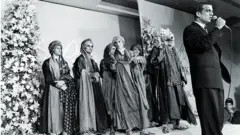Rohit Bal, a name synonymous with opulent Indian fashion and celebrated globally for his masterful blend of traditional aesthetics with contemporary design, has passed away at the age of 63. His demise marks the end of an era for Indian fashion, leaving behind a legacy that has profoundly shaped the industry.
Bal’s journey in fashion began in the nascent stages of India’s fashion awakening in the 1990s. He was among the pioneers who transformed fashion designing into a respected and sought-after profession. Countless designers who followed him acknowledge his foundational role in paving their paths to success. His recent return to the runway at India Fashion Week, despite his frail health, was a poignant moment, celebrated as a testament to his enduring passion and influence.
Known for his profound understanding of Indian textiles and an unwavering commitment to intricate detailing, Rohit Bal’s designs were more than just clothing; they were works of art. His innovative creations transcended geographical boundaries, adorning Hollywood luminaries and supermodels, solidifying his status as a designer who seamlessly fused India’s rich cultural heritage with modern sensibilities.
Born in Srinagar, Kashmir, in 1961, Rohit Bal’s early life experiences in the culturally rich valley profoundly influenced his design philosophy. A history graduate from Delhi’s prestigious St Stephen’s College, he initially gained practical business acumen working in his family’s export business. His formal foray into fashion began at the National Institute of Fashion Technology (NIFT) in Delhi, after which he launched his eponymous label in 1990. His brand rapidly expanded, establishing stores across India, the Middle East, and Europe, a testament to his global appeal.
Rohit Bal’s design ethos, as he articulated on his website, was a unique amalgamation of “history, folklore, village craft, and dying arts,” resulting in imaginative and groundbreaking pieces. His recognition as India’s ‘Master of fabric and fantasy’ by Time magazine in 1996 underscored his exceptional talent and innovative approach to design. His creations resonated internationally, attracting a clientele that included Hollywood actress Uma Thurman and supermodels like Cindy Crawford, Naomi Campbell, and Pamela Anderson. Tennis star Anna Kournikova’s walk on his Paris runway in 2001 further cemented his global stature.
The lotus and peacock motifs became iconic signatures in Rohit Bal’s designs, often rendered on luxurious fabrics like velvet and brocade. His creations were elaborate and regal, drawing inspiration from India’s historical grandeur and royal heritage. Beyond his own label, Bal extended his creative vision to collaborations and endorsements, designing for shoes, linen, and partnering with textile giants. He even ventured into jewelry and luxury watches, showcasing his diverse design capabilities. Recognizing the evolving consumer landscape, he also launched a children’s line, demonstrating his keen business acumen.
Rohit Bal’s influence permeated popular culture, extending to costume design for the renowned Indian game show Kaun Banega Crorepati and British Airways cabin crew uniforms. In 2014, he launched his prêt-à-porter line with online retailer Jabong, aiming to democratize access to his design aesthetic. He envisioned a clear distinction between his exclusive Rohit Bal stores, showcasing “handmade pieces of art,” and his prêt line, catering to a broader audience.
Reflecting on his design process, Bal emphasized the foundational role of fabric, describing it as “the lifeblood of fashion.” His sensory connection with textiles stemmed from his childhood in Srinagar, recalling the luxurious feel of jamawar shawls and the warmth of shahtoosh saris. While his early years in Srinagar were idyllic, the onset of violence in the region led to the family’s relocation to Delhi, marking a significant shift in his life. His early sartorial curiosity emerged at age 11 when he designed his own cowboy pants, signaling the beginning of his lifelong journey in fashion.
Beyond fashion design, Rohit Bal showcased his diverse talents by designing the opulent interiors of Delhi’s Veda restaurant, further cementing his reputation for extravagant and detailed aesthetics. Despite his flamboyant persona, often dubbed “the bad boy of fashion” by the Indian media, Bal was known for his insightful understanding of design and business. He remained confident in the unique position of Indian designers, even with the increasing presence of international brands in the Indian market.
Rohit Bal’s passing leaves a void in the Indian fashion landscape. His contributions as a designer, innovator, and pioneer have indelibly shaped the industry, and his legacy will continue to inspire generations of designers to come. His work remains a testament to the enduring appeal of Indian craftsmanship and the power of blending tradition with modernity in the global fashion arena.
